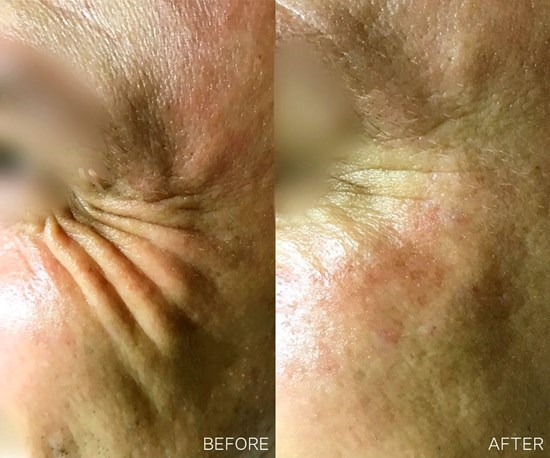This article has been verified for CPD. Click the button below to answer a few
short questions and download a form to be included in your CPD folder.
There is a growing demand for aesthetic procedures for men. Anna Baker provides an overview of the popular treatments and explains the important differences between male and female facial anatomy that need to be considered before treating these patients.
Recent data confirms that male aesthetic (surgical and non-surgical) procedures continue to rise in popularity, with Botulinum toxin (BoNTA) remaining as one of the most sought-after treatments [1]. Other popular modalities include laser skin resurfacing, laser hair removal and dermal fillers, as well as microdermabrasion [1].
In light of the increasing rise in demand for aesthetic procedures for men, medical aesthetic practitioners can familiarise themselves with some of the specific senescent changes to the face and body that males undergo. This can help to build knowledge and confidence in the practitioner’s assessment and planning the most appropriate treatment pathway based on the male patient’s concerns.
Male facial anatomical considerations
Facial beauty ideals can vary according to culture, and subjectively change with time. However, anatomical age-related changes generally follow a defined pattern in both men and women [2].
Bone remodelling continues throughout life and can be influenced by regional changes in the soft tissue related to each bone, such as muscles, tongue, lips and skin, among others [3]. The patterns and distribution of bone remodelling have been well described anthropometrically with reference to facial ageing in both men and women [4].
The male forehead and brow region is usually larger, flatter inferiorly and convex superiorly [5]. In addition, the male face can be characterised by a more prominent frontal nasal suture, with a low / horizontal brow position on a more prominent orbital ridge and a strong supraorbital rim [6]. With respect to the male eye, this is set usually deeper than females, with the location of the upper eyelid crease approximately 8mm above the eyelid margin [5]. Male noses typically manifest a wide and straight dorsum, with an absent supratip break and nasolabial angle of approximately 90-95 degrees [7]. Perioral concerns in the ageing male face may manifest through a decrease of upper lip thickness, a decrease in cutis thickness, thinning of the orbicularis muscle, as well as thinning of the bottom lip [8]. Male chins and jawlines generally have a wider bigonial distance with a square and anteriorly projected skin with accentuated gonial definition [8]. The male midface typically demonstrates a larger zygomatic arch, as well as a relatively flat mid-cheek [7,9].
Skincare
Historically, many studies which have sought to analyse skincare market trends as well as skincare products have sampled females as the majority of subjects [10]. Some data supports a rise in male patients investing in skincare, in addition to aesthetic procedures [11]. However, there is a paucity in data on global demand with respect to male patients using skincare products. In the author’s experience, it is apparent that there has been an increase in male patients accessing skincare consultations and adopting facial product regimens. It is possible that this may be due to increased use of social media platforms and an increased reliance on remote working through online systems and video conferencing, due to impact of the global SARS-CoV-2 pandemic.
There are similar biochemical and cellular processes which occur in both male and female skin. Specific structural differences such as skin thickness, quantity of collagen / rate of decline, the amount of subcutaneous fat, as well as the rate at which facial ageing occurs are some of the most important differences [12].

Before & immediately after treatment to the crow’s feet area with the
VISCODERM Hydrobooster (IBSA) injected into the crow’s feet area.
Key differences between male and female skins are largely defined by the influence and effects of different circulating hormones [13]. Female skin is affected mainly by oestrogen, whereas male skin is largely affected by androgens, such as testosterone and 5a-dihydrotestosterone [14]. The positive protective benefits of oestrogen for women are widely reported, and include its important role in facilitating collagen synthesis, as well as production of hyaluronic acid and elastin fibres. In addition, oestrogen has been shown to positively influence the water-binding capacity in skin, supporting improved skin barrier function [15]. Moreover, females prior to menopause have greater subcutaneous density, which is advantageous for skin firmness. Testosterone can thicken the tissue in both the epidermal and dermal layers of the skin, and also facilitate collagen production [10]. Furthermore, testosterone helps to stimulate terminal beard hair growth on the face, which is coarser, gives protection against UV rays and helps to prevent against wrinkle / line formation, specifically in facial areas with beard hair [16]. Beard shaving can expose skin that would otherwise be protected to UV radiation, potentially triggering irritation and pseudofolliculitis barbae, and compromising the skin barrier.
Male skin can benefit from a variety of chemical exfoliating ingredients, such as alpha hydroxy acids (AHAs), depending on individual concerns. It is reported that males can demonstrate reduced levels of hydration at approximately 40 years of age, with the highest rate of trans epidermal water loss (TEWL) between 50-59 years of age, possibly linked to reduced testosterone levels [17]. Dryness and textural roughness can be common concerns, owing to male skin potentially being more vulnerable to environmental stressors, such as UV, heat and stress [18]. Skincare products which contain antioxidants, humectants with barrier conditioning benefits, are an essential part of male skin health, along with broad spectrum SPF.
Non-surgical procedures
The male upper face is characterised by prominent supraorbital ridges, with frontal bossing which can result in deep-set eyes. The tear trough may be relatively deeper than a female, and a concern which can be effectively treated with hyaluronic acid dermal fillers [8]. In addition, the quality of the skin around periorbital area can be improved using mesotherapy or skin boosters [19].
Treatment with BoNTA is an effective and popular option – particularly for upper facial areas of concern, such as dynamic lines across the forehead, the crow’s feet and frown lines. Common treatment aims using neurotoxin are to preserve a lower, and more horizontal position of the brows while improving the appearance of forehead lines. Excessive brow arching and complete reduction of forehead lines is not desirable and can appear unnatural in keeping with male features [8]. In addition, judicious use of BoNTA around the crow’s feet can effectively soften dynamic lines but is of limited benefit to improve more established wrinkles [2]. Typically, male patients exhibit greater muscle mass than females and require greater toxin dosing to achieve effective treatment outcomes [9]. Specific dermal fillers and skin boosters with appropriate rheology can be administered into focal established lines to reduce wrinkle depth [20].
Non-surgical rhinoplasty is a popular option for male patients and can address a variety of concerns [21]. Typically, the nose is slightly longer and often wider in male patients, with an angle preference of approximately 90-95 degrees [8]. Reshaping an ageing male midface is generally suited to reinforcing the lateral aspect. Adding volume to the medial part of the face, in most cases, may feminise or create an unnatural appearance.
The male lower face is usually squarer, with a strong jawline. Anterior mandible projection is usually more desirable in a male patient which can be effectively achieved with dermal fillers [8]. Skin laxity and overall quality can be addressed with a number of energy-based modalities, ranging from radiofrequency with / without microneedling, to ablative and non-ablative lasers – to name just a few [22].
Non-surgical body contouring continues to rise in popularity with male patients, specifically cryolipolisis, as well as high intensity focused electromagnetic field technology which aids in building and strengthening muscle tone [23,24].
Surgical procedures
American Society of Aesthetic Plastic Surgery (ASAPS) (2020) data confirms that a number of surgical aesthetic procedures remain popular with male patients, including nose reshaping, eyelid surgery, liposuction, gynaecomastia treatment, as well as ear surgery. Collectively, it would appear that these procedures show a reduction in recorded numbers performed from 2019 – in part due to the effects of the global SARS-CoV-2 pandemic, as well as the growth in demand for non-surgical procedures.
Conclusion
While the specialism of aesthetic medicine has traditionally focused on treating female patients, an emerging body of literature is acknowledging a growing demand for procedures for male patients. Developing an awareness of gender-specific preferences, as well as facial dimorphism, is important to achieve successful treatment outcomes in male patients. The literature to date confirms the approaches and knowledge required to adequately select and provide a variety of aesthetic procedures to meet the needs of aesthetic male patients.
References
1. American Society for Plastic Surgeons, 2020:
https://www.plasticsurgery.org/documents/
News/Statistics/2020/cosmetic
-procedures-men-2020.pdf
2. Keaney TC, Anolik R, Braz A, et al. The Male Aesthetic Patient: Facial Anatomy, Concepts of Attractiveness, and Treatment Patterns. J Drugs Dermatol 2018;17(1):19-28.
3. Avelar LET, Cardoso MA, Bordoni LS, et al. Aging and Sexual Differences of the Human Skull. Plast Reconstr Surg Glob Open 2017;5:e1297.
4. Shaw RB, Katzel EB, Koltz PF, et al. Aging of the Facial Skeleton: Aesthetic Implications and Rejuvenation Strategies. Plast Reconstr Surg 2011;127:374-83.
5. Mydlova M, Dupej J, Koudelova J, Veleminska J. Sexual dimorpphism of facial appearance in ageing human adults: A cross-sectional study. Forensic Science International 2015;257(519):e1-9.
6. Chatham DR. Special considerations for the male patient: things I wish I knew when I started practice. Facial Plast Surg 2015;21:232-9.
7. Sadick N. Volumetric Structural Rejuvenation for the Male Face. Dermatol Clin 2018;36:43-8.
8. De Maio M. Ethnic and Gender Considerations in the use of Facial Injectables: Male Patients. Plast Reconstr Surg 2015;136:40s-43s.
9. Farhadian J, Bloom BS, Brauer JA. Male Aesthetics: A Review of Facial Anatomy and Pertinent Clinical Implications. J Drugs Dermatol 2015;14(9):1029-34.
10. Sikora BC, Wortzman M, Nelson DB, Dover JS. A pilot study evaluating the efficacy and tolerability of a comprehensive, hydrating topical antioxidant developed specifically for men. J Cosmet Dermatol 2021;20(9):2816-23.
11. de Lacerda D, Thioly-Bensoussan D, Burke K. Cosmeceuticals for men. Cutis 2013;Suppl:6-12.
12. Draelos ZD. Cosmeceuticals for male skin. Dermatol Clin 2018;36:17-20.
13. Mizukoshi K, Akamatsu H. The investigation of the skin characteristics of males focusing on gender differences, skin perception, and skin care habits. Skin Res Technol 2013;19(2):91-9.
14. Shu YY, Maibach HI. Oestrogen and skin: therapeutic options. Am J Clin Dermatol 2011;12(5):297-311.
15. Lephart ED. A review of the role of estrogen in dermal aging and facial attractiveness in women. J Cosmet Dermatol 2017;17:282-8.
16. Makino ET, Jiang LI, Tan P, et al. Addressing male facial skin concerns: clinical efficacy of a topical skincare treatment product for men. J Drugs Dermatol 2018;17(3):301-6.
17. Leubberding S, Krueger N, Kerscher M. Skin physiology in men and women: in vivo evaluation of 300 people including TEWL, SC hydration, sebum content and skin surface pH. Int J Cosmet Sci 2013;35:477-83.
18. Oblong JE. Male skin care; Shaving and moisturization needs. Dermatol Ther 2012;25(3):238-43.
19. Keaney TC. “Man-some”: A Review of Male Facial Ageing and Beauty. J Drugs Dermatol 2017;16(6):91-3.
20. Beatini A, Persini P, Russo R. “REAL LIFE” efficacy evaluation of a hyaluronic acid gel suitable for deep hydration and fine wrinkles correction. Aesthetic Medicine 2019;5(3):22-7.
21. Kassir R, Venkataram A, Malek A, Rao D. Non-Surgical Rhinoplasty: The Ascending Technique and a 14-Year Retrospective Study of 2130 Cases. Aesthet Plast Surg 2020;45:1154-68.
22. Dayan E, Chia C, Burns AJ, Theodorou S. Adjustable Depth Fractional Radiofrequency Combined With Bipolar Radiofrequency: A Minimally Invasive Combination Treatment for Skin Laxity. Aesthet Surg J 2019;8(39):Suppl 3:s112-s119.
23. Ingargiola MJ, Motakef S, Chung MT, et al. Cryolipolysis for fat reduction and body contouring: safety and efficacy of current treatment paradigms. Plast Reconstr Surg 2015;135(6):1581-90.
24. Alexiades M. High Intensity Focused Electromagnetic Field (HIFEM) Devices in Dermatology. J Drugs Dermatol 2019;18(11):1088.
Declaration of competing interests: KOL for Aesthetic Technologies, IBSA, HA-Derma, NeoStrata & Skinbetter Science.
COMMENTS ARE WELCOME







